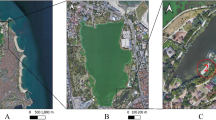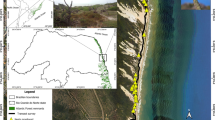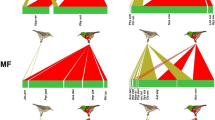Abstract
Reproductive behavior of the herbivorous damselfishStegastes nigricans was studied. Both males and females held individual feeding territories, which were distributed contiguously and formed colonies. Spawning season was from June to September. Females visited males' territories and spawned eggs on the algal nest. Males tended eggs until hatching but exhibited less care taking behavior than other damselfishes. The mating system was promiscuous in that both males and females spawn with several mates, even within a single day. However, only 1 female was accepted in the nest at a time. The restriction of the number of mates in the nest may be an adptation to prevent the sneaking which was often conducted by other males of the same colony, and may also be avoidance of disturbing the spawning female. Most spawnings were done among members of the same colony and inter-colonial spawnings were rare (27 cases of 333 spawnings observed). The results of this study suggest that colonial distribution ofS. nigricans may bring several benefits in reproduction to the colony members (e.g. easy mate findings within fellow colony members), but also seems to bring costs (e.g. restriction of number of mates).
Similar content being viewed by others
References
Albrecht, H. 1969. Behaviour of four species of Atlantic damselfishes from Columbia, South America, (Abudefduf saxatiles, A. taurus, Chromis multineata, C. cyanea; Pisces, Pomacentridae).Z. Tierpsychol., 26: 662–676.
Allen, G.R. 1975. Damselfishes of the South Seas. T.F.H. Publ., Neptune City, New Jersey, 240 pp.
van den Berghe, E.P., F. Wernerus & R.R. Warner 1989. Female choice and the mating cost of peripheral males.Anim. Behav., 38: 875–884.
Clarke, T.A. 1971. Territory boundaries, courtship, and social behavior in the garibaldi,Hypsypops rubicunda (Pomacentridae).Copeia, 2: 295–299.
Emlen, S.T. & N.J. Demong 1975. Adaptive significance of synchronized breeding in a colonial birds: A new hypothesis.Science, 188: 1029–1031.
Fishelson, L. 1970. Behaviour and ecology of a population ofAbudefduf saxatilis (Pomacentridae, Teleostei) at Eilat (Red Sea).Anim. Behav., 18: 225–237.
Foster, S.A. 1989. The implications of divergence in spatial nesting pattern in the geminate Carribean and Pacific sergeant major damselfishes.Anim. Behav., 37: 465–476.
Gronell, A.M. 1989. Visiting behaviour by females of the sexually dichromatic damselfish,Chrysiptera cyane (Teleostei: Pomacentridae): a probable method of assessing male quality.Ethology, 81: 89–122.
Gross, M.R. 1984. Sunfish, salmon, and the evolution of alternative reproductive stategies and tactics in fishes. In: G.W. Potts & R.J. Wootom (eds.)Fish reproduction: strategies and tactics. pp. 55–75. Academic Press, London.
Gross, M.R. & A.M. MacMillan 1981. Predation and the evolution of colonial nesting in bluegill sunfish (Lepomis macrochirus).Behav. Ecol. Sociobiol., 8: 163–174.
Harrington, M.E. & G.S. Losey 1990. The importance of species identification and location of interspecific territorial defense by the damselfish,Stegastes fasciolatus.Evn. Biol. Fish., 27: 139–145.
Hoelzer, G.A. 1990. Male-male competition and female choice in the Cortez damselfish,Stegastes rectifraenum.Anim. Behav., 40: 339–349.
Hoogland, J.L. & P.W. Sherman 1976. Advantages and disadvantages of bank swallow (Riparia riparia) coloniality.Ecol. Monogr., 46: 33–58.
Horn, H.S. 1968. The adaptive significance of colonial nesting in the brewer's blackbird (Euphagus cyanocephalus).Ecology, 49: 682–694.
Itzkowitz, M. 1977. Spatial organization of the Jamaican damselfish community.J. Exp. Mar. Biol. Ecol., 28: 217–241.
Itzkowitz, M. 1985. Aspects of the population dynamics and reproductive success in the permanently territorial beaugregory damselfish.Mar. Behav. Physiol., 12: 57–69.
Itzkowitz, M. 1991. Habitat selection and subsequent reproductive success in the beaugregory damselfish.Env. Biol. Fish. 30: 287–293.
Knapp, R.A. & R.R. Warner 1991. Male parental care and female choice in the bicolor damselfish,Stegastes partilus: bigger is not always better.Anim. Behav., 41: 747–756.
Kohda, M. 1984. Intra-and interspecific territoriality of a temperate damselfishEupomacentrus altus, (Teleostei: Pomacentridae).Physiol. Ecol. Japan, 21: 35–52.
Krebs, J.R. 1974. Colonial nesting and social feeding as strategies for exploiting food resources in the great blue heron (Ardea herodias).Behavior, 51: 99–134.
Kuwamura, T. 1987. Male mating territory and sneaking in a maternal mouthbrooder,Pseudosimochromis curvifons (Pisces; Cichlidae).J. Ethol., 5: 203–206.
Magnhagen, C. 1991. Predaion risk as a cost of reproduction.TREE., 6: 183–186.
Mahoney, B.M. 1981. An examination of interspecific territoriality in the dusky damselfish,Eupomacentrus drosopunicans Poey.Bull. Mar. Sci., 31: 141–146.
Masuda, H., K. Amaoka, C. Araga, T. Uyeno & T. Yoshino 1984. The fishes of the Japanese Archipelago. Tokai University Press., Tokyo. pp. 456.
Montgomery, W.L. 1980. Comparative feeding ecology of two herbivorous damselfishes (Pomacentridae: Teleostei) from the gulf of California, Mexico.J. Exp. Mar. Biol. Ecol., 47: 9–24.
Moyer, J.T. 1975. Reproductive behavior of the damselfishPomacentrus nagasakiensis at Miyake-Jima, Japan.Japan. J. Ichtyol., 22(3): 151–163.
Moyer, J.T. 1991. Comparative Mating Strategies of Labrid Fishes. The Watanabe Ichthyological Institute. Tokyo. pp. 90
Myrberg, A.A. Jr. 1972. Social dominance and territoriality in the bicolor damselfish,Eupomacentrus partitus (Poey) (Pisces: Pomacentridae).Behaviour, 41: 207–231.
Myrberg, A.A., Jr. & R.J. Riggio 1985. Acoustically mediated individual recognition by a coral reef fish (Pomacentrus partitus).Anim. Behav., 33: 411–416.
Ochi, H. 1985. Termination of parental care due to small clutch size in the temperate damselfish,Chromis notata.Envir. Biol. Fish., 12(2): 155–160.
Ochi, H. 1986. Breeding synchrony and spawning intervals in the temperate damselfishChromis notata.Env. Biol. Fish., 17: 117–123.
Prappas, J.M., L.E. Greene & R. White 1991. Reproductive behavior of the sergeant major,Abudefduf sexatilis, within a closed system aquarium.Env. Biol. Fish., 31: 33–40.
Robertson, D.R., S.G. Hoffman & J.M. Sheldon 1981. Availability of space for the territorial Caribbean damselfishEupomacentrus planifrons.Ecology, 62: 1162–1169.
Ross, R.M. 1978. Reproductive behavior of the anemonefishAmphiprion melanopus on Guam.Copeia, 1: 103–107.
Sano, M., M. Shimizu & Y. Nose 1984. Food habits of Teleostean reef fishes in Okinawa Island, southern Japan.Univ. Mus., Univ. Tokyo. Bull., 25: 1–128.
Schmale, M.C. 1981. Sexual selection and reproductive success in males of the bicolor damselfish,Eupomacentrus partitus (Pisces: Pomacentridae).Anim. Behav., 29: 1172–1184.
Sigurjónsdóttir, H. & K. Gunnarsson 1989. Alternative tactics of arctic charr,Salvelinus alpinus, in Thingvallavatn, Iceland.Env. Biol. Fish., 26: 159–176.
Sikkel, P.C. 1989. Egg presence and developmental stage influence spawning-site choice by female garibaldi.Anim. Behav., 38: 447–456.
Thresher, R.E. 1984. Reproduction in Reef Fishes. T.F.H. Publ., Neptune City, New Jersey. 399 pp.
Wellington, G.M. & B.C. Victor 1988. Variation in components of reproductive success in an undersaturated population of coral-reef damselfish: A field perspectivc.Amer. Natur., 131: 588–601.
Williams, A.H. 1978. Ecology of threespot damselfish: Social organization, age structure, and population stability.J. Exp. Mar. Biol. Ecol., 34: 197–213.
Yamamoto, T. 1976. Seasonal variation in abundance, size composition and distributional patterns of residing damselfishes in Sesoko Island, Okinawa.Sesoko Mar. Sci. Lab. Tech. Rep., 4: 19–42.
Yamamoto, T. 1979. Distribution and abundance ofEupomacentrus nigricans (Lacepeda) (Pisces, Pomacentridae) in the Ryukyu Islands.Sesoko Mar. Sci. Lab. Tech. Rep., 6: 3–32.
Author information
Authors and Affiliations
About this article
Cite this article
Karino, K., Nakazono, A. Reproductive behavior of the territorial herbivoreStegastes nigricans (Pisces: Pomacentridae) in relation to colony formation. J. Ethol. 11, 99–110 (1993). https://doi.org/10.1007/BF02350043
Received:
Accepted:
Issue Date:
DOI: https://doi.org/10.1007/BF02350043




